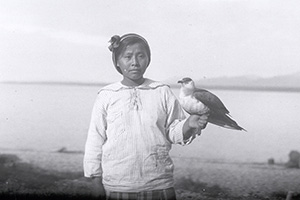
Courtesy of National Park Service
Lake Clark National Park and Preserve covers nearly 2.6 million acres and is a composite of ecosystems representative of many regions of Alaska. This richly diverse and magnificent land has also been the homeland for Native Alaskan peoples for centuries. The vast undeveloped areas of the park and preserve include the rugged Chigmit Mountains bordered by the Aleutian Range to the south and the Alaska Range to the north, rolling foothills, active volcanoes, alpine lakes, dramatic glaciers, scenic lakes, boreal forests, open expanses of tundra, jagged coastlines, and three national wild rivers.
Spectacular diversity in the vegetation and wild life abounds in this vast wilderness. Land mammals include Dall sheep, caribou, moose, wolves, and black and brown bears. The Lake Clark watershed is the perfect habitat for sockeye salmon, and the shallow bays of Cook Inlet are the home of harbor seals, Steller sea lions, sea otters, harbor porpoises, and beluga whales. Lake Clark National Park and Preserve helps protect the scenic beauty of this region and the cultural resources of the Native Alaskan peoples.
Nearly 14,000 years ago sometime after the close of the Last Great Ice Age, the first human settlers came to the Lake Clark region. These people were nomadic hunters who encountered and hunted many animals that no longer exist today. While little evidence remains that would give us clues about their lifestyles, habits, and identities, archeologists have found lichen-covered and wind-polished tools in places of high elevation where these nomadic hunters likely camped to watch for animals to hunt. While the limited evidence at these early sites makes it difficult to determine exactly what was happening 14,000 years ago, more recent archeological sites throughout the Park and Preserve offer evidence about Native Alaskan culture.
Located on the shore of Lake Clark, the Kijik Archeological District, a National Historic Landmark, is comprised of more than a dozen archeological sites. The district includes the surface remains of Dena’ina Athabaskan Indian settlements dating from pre-European contact to the abandonment of Kijik village in the early 20th century.
The Dena’ina Athabaskan people settled in this region sometime before the start of the Little Ice Age (1350 to 1900 AD). Before the arrival of Russians and Euro-Americans, the Dena’ina built at least four different types of houses, some including semi-subterranean structures. Evidence from these archeological sites within the National Historic Landmark suggests that the Dena’ina lived in the immediate vicinity of Lake Clark for quite some time before moving to the Kijik village. There is debate, however, as to the origins of the Dena’ina and their arrival in Lake Clark. Some scholars argue that the Dena’ina were a coastal people who moved inland in response to Russian contact, while other scholars argue that the Dena’ina came from the Upper Stony and Mulchatna River region.
By sometime in the 1700s or early 1800s, the Dena’ina constructed the village of Kijik on the shore of Lake Clark. Kijik, meaning “a place where people gathered,” was a large, multi-village community to which many of the Dena’ina people who live near Lake Clark today can trace their ancestors. At its height, the community contained many houses and a Russian Orthodox Church. Estimates suggest that between 1875 and 1890, the population of Kijik ranged from 150 to 174 people.
Throughout the 19th century, contact between Kijik residents and Russians, Europeans, and Americans steadily increased, as evidenced by the western trade goods found at the site of the village. These goods likely had a significant impact on the Dena’ina’s material culture and way of life. Constructed in Kijik in 1889, the Russian Orthodox Church is another example of the cultural exchanges that were taking place. The remains of the Russian Orthodox Church reflect an adaptation of Alaskan Indian workmanship and materials to the traditional style of Russian church architecture.
Contact with Russians, Europeans, and Americans not only influenced the economic, religious, and cultural patterns of the Kijik residents, it also significantly affected their health as they faced exposure to diseases with which they had no experience. Flu and measles outbreaks from 1901-1909 prompted many families to leave for Old Nondalton, Tanalian Point, or elsewhere, and by 1909, the people completely abandon the village.
Small aircraft provide access to Lake Clark National Park and Preserve because of the lack of roads. In the park, courageous backpackers can hike the historic Telaquana Trail, which the Dena’ina used as both a transportation corridor and an important subsistence area. The hike is a journey similar to what Kijik residents would have experienced when traveling between Kijik Village and Telaquana Lake to the north. Fishing, hiking, day-trips for fly-in fishing and viewing bears and other wildlife, backpacking trips, float trips, and sport fishing are all popular things to do in the park. For most activities, visitors must be well equipped and self sufficient when they arrive. It is important that visitors make arrangements in advance with a guide, outfitter, or lodge operator.
Lake Clark National Park and Preserve, a unit of the National Park System, is located on 2.6 million acres in Alaska. The Park and Preserve is not on the road system and access is primarily by small aircraft. Air taxi services provide transportation to the park. The field headquarters and visitor center are located in Port Alsworth, AK.
The park is open year-round, while most people visit between June and September. The Port Alsworth visitor center is open Monday through Saturday from 8:00 am to 5:00 pm June through August and Monday through Friday from 8:00am to 5:00pm September through May. The Port Alsworth Field Headquarters are open year-round, Monday through Friday from 8:00am to 5:00pm. For more information, visit the National Park Service Lake Clark National Park and Preserve website or call the visitor center at 907-781-2218 or the field headquarters at 907-781-2218.
Last updated: August 23, 2017
